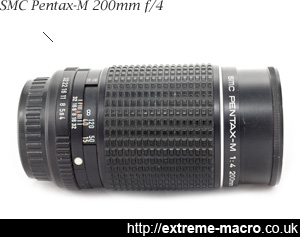SMC Pentax-M 200mm f/4
by Johan J Ingles-Le Nobel
Last updated August 31, 2017
Like all Pentax-M series lenses, the 200mm f/4 is sharp, small and beautifully constructed.
expect to achieve 10:1 using this lensThis is a good, inexpensive telephoto prime lens that works just fine as a tube lens with an infinite objective.

SMC Pentax-M 200mm f/4, which gives me 10:1 as a tube lens using a Nikon CFI BE 10X NA 0.25 infinite objective. A good, inexpensive telephoto prime lens that works just fine as a tube lens with an infinite objective.
200mm Magnification
Nikon, Mitutoyo and Leica Infinite objectives all achieve their rated magnification using a 200mm tube lens.
Therefore with a 10x infinite objective, expect to achieve 10:1 using this lens, which in the case of APSC means a view of 2.37 by 1.57 mm.
The filter diameter of the SMC Pentax-M 200mm f/4 is 52mm which is a little annoying as the rest of my Pentax stuff is 49mm. The lens is constructed with 6 elements in 5 groups.
SMC Pentax-M 200mm f/4 Performance
a very marked depth to shotsThe colour rendering is superb, especially for blues, and the image quality is uniform across the whole APSC frame. It has a very marked depth to shots - almost a 3D type of look.
The 8 aperture blades are a nice touch, chromatic aberration is under control one stop down and at f/5.6.the SMC Pentax-M 200mm f/4 seems to have great uniformity across the frame and no feeble zoom-type centring issues.
no feeble zoom-type centring issuesThe lens also seems to give better than expected results when coupled with a moderate teleconverter, for example a 1.5x. This potentially makes it usable to push a 10x up to 15:1.
Pentax-M Series Lenses
The SMC Pentax-M series of lenses were launched in the very late 1970s, a compact successor range of lenses to the first multicoated plain SMC series. This was the second series using the then revolutionary K mount. Being -M series there is no auto aperture with this lens series, which differentiates it from the successor SMC-A series of Pentax lenses. It is thought that the -M designation maybe a nod to the then Asahi factory in Mashiko. Optically they benefit from the SMC coating and perform significantly better on today's colour cameras than the earliest Pentax lenses which were designed for black and white, and can therefore show aberration with colours not being corrected for colour use.
Related Articles


